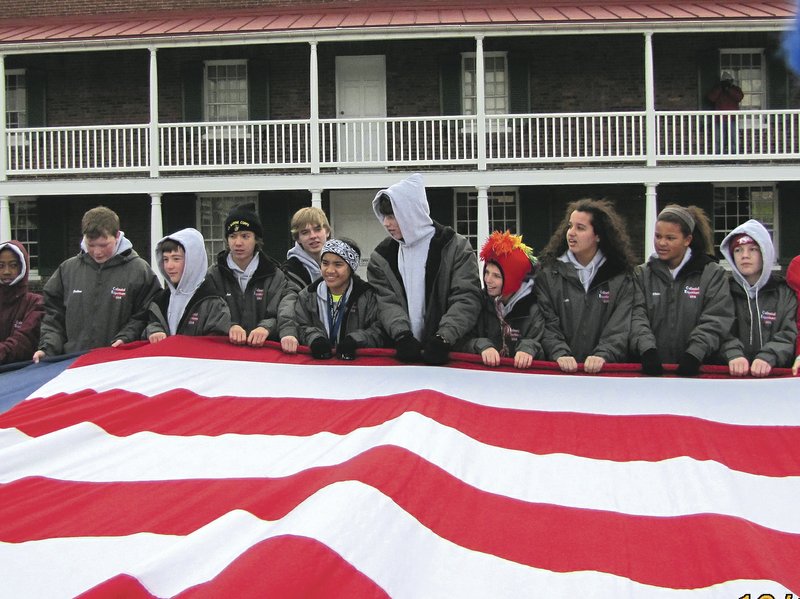Who is George Wythe? When and where was the first permanent English settlement established in the New World? What happened at Fort McHenry?
Fifty-one ninth-graders from Springdale's junior high schools learned the answers to these questions during the last school year. More students have the opportunity to do so this year.
As school starts this week, eighth-grade history teachers will introduce the Colonial Experience trip, sponsored by the Five-Mile Foundation. In early December, students from each school in Springdale will travel to the East Coast and the sites that made the United States -- including Jamestown, Colonial Williamsburg, Washington, D.C., and Philadelphia.
The Five-Mile Foundation has sponsored the all-expenses-paid trip for 20-plus years. Students from Springdale join students from 11 schools in Arkansas, Oklahoma, Kansas, Kentucky and New York City.
Chosen for the trip based on their essays about American history, youngsters attend an intensive extracurricular class for 11 weeks, during which history teachers Thomas Pittman, Lisa Spears and Dean Alexander share the history of the sites to enrich the students' experiences.
"He was Thomas Jefferson's law professor," Mason McConnell, one of last year's travelers, said of Wythe. "His nephew poisoned him, and we saw his grave in Richmond (Va.)"
"And Thomas Jefferson was a big deal because he wrote the Declaration (of Independence)," added Diana Campos.
The students visited Wythe's restored home in Colonial Williamsburg, greeted on a chilly fall day by a warm fire in the fireplace. "The banister (in the house) was the original one -- the same one used by Thomas Jefferson," said Kariel Thornton. Students told of the elaborate, colored silk wallpaper -- which was a sign of wealth, said Sierra Landrith. One room of Wythe's home was dedicated as a classroom, which today includes maps, a period microscope and plant specimens. And the students also got a kick out of having their pictures taken sitting in Wythe's five-seat privy.
Students also traveled to the site of Jamestown, overlooking the James River, now preserved as part of the Colonial National Park by the National Park Service.
"(Jamestowne) was the first established colony for the U.S.," said Kyle Garibaldi. "Established in 1607," added Ethan Hudgons.
The group of 104 upper-class men came to the New World looking for gold and silver, but found none, said Adrian Gonzalez.
"The first year there was really bad," said Maren Martfeld. "They didn't come to a paved world."
"They picked a swamp almost (to establish the settlement)," said Hayden Holt. They faced insects, disease, native Indians and dissent among themselves.
Later, Springdale students climbed the star-shaped ramparts of the Fort McHenry National Monument and Historic Shrine. "It was built to defend Baltimore," explained Colin McKenzie.
British ships fired on Baltimore's Fort McHenry in a battle during the war of 1812, as they tried to reclaim the United States for the Empire. Francis Scott Key, author of The Star-Spangled Banner, was held on a British ship during the fight. When the morning sun rose and the smoke cleared, he knew the flag flying above the fort would tell the story of the victory: It was the American flag. From that experience, Key wrote the song that would become the National Anthem, and students visited the fort in the year of the 200th anniversary of the song.
"I could imagine the bombs," Martfeld said.
Along with those from the other schools, Springdale students helped unfurl a giant version of the American flag, and it took every one of the 164 youngsters present to hold the 42-by-30-foot flag -- including 15 stars and stripes, which Key saw that fateful morning. Unfortunately, the weather was too windy for the flag -- the same size as that 1814 garrison flag -- to be raised over the fort, but "we all took a hold on the flag, and right then and there, we could touch a piece of history," Gonzales said.
A trip to Colonial Williamsburg as a child "changed my life," John Archer, officer for the Five-Mile Trust, often repeats. And he wants the same for today's children -- especially those who otherwise might not have the chance to put their hands on this history.
"The trip is to help future leaders to have a better understanding of our nation's traditions and background to ground them for the future and to create a understanding of what is needed to have a better nation and world," said Pittman, one of the teachers. "We want them to go back to our communities and be the leaders, so our history is not lost. They come back home with a real understanding and hope for the future."
NAN Our Town on 08/20/2015

